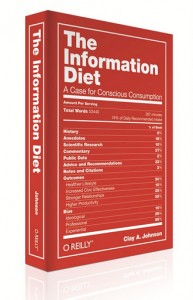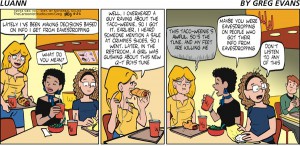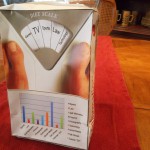 This project is usually assigned on the first day of the semester. Since some students have either not bought their text or are waiting for it to be delivered, I tend to hold off for at least a week before assigning readings from the text. In lieu of assigned readings, I introduce the Information Diet project, a project that was inspired by the book of the same name by Clay Johnson (full title: The Information Diet: A Case for Conscious Consumption).
This project is usually assigned on the first day of the semester. Since some students have either not bought their text or are waiting for it to be delivered, I tend to hold off for at least a week before assigning readings from the text. In lieu of assigned readings, I introduce the Information Diet project, a project that was inspired by the book of the same name by Clay Johnson (full title: The Information Diet: A Case for Conscious Consumption).
The assignment is fairly straightforward. Students are directed to maintain a daily log of their information consumption. They record everything they read, watch, or listen to, ranging from social media (Facebook, Twitter, email) to school textbooks, and everything in between. This they do for one week. At the end of the week, they are directed to analyze their “data.” Their analysis will be both visual (i.e., a graphic of some kind) and written (a 2-page discussion of what they discovered).
I created this assignment and have taught it twice. I like it. I like that students begin to take ownership of their media consumption. Most of them, being members of Generation Y (the so-called “millennials,” aka “digital natives”), spend an inordinate amount of time on electronic media. This isn’t always a good thing, as many of them come to see.
 Clay Johnson’s analogy of information consumption to food consumption is apt: students begin to see that their information “diet” consists mostly of “junk” food. Many of them, upon completing this project, claim that they hope to change their “diet” and try to consume “healthier” information. I hope they follow through.
Clay Johnson’s analogy of information consumption to food consumption is apt: students begin to see that their information “diet” consists mostly of “junk” food. Many of them, upon completing this project, claim that they hope to change their “diet” and try to consume “healthier” information. I hope they follow through.
MATERIALS
Here are two PowerPoint shows that I created to introduce students to this assignment.
PPT INFORMATION DIET ASSIGNMENT PART I 2017
PPT INFORMATION DIET 2017 ASSIGNMENT PART 2 Analyzing Your Data
Here’s the assignment as I designed it in two parts. I created a simple log sheet which students may use or adapt (or design their own system of record-keeping).
Information Diet Assignment Part I 2017
SAMPLE STUDENT ANALYSES AND PROJECTS
Spring 2013 (student Gregory Long)
Spring 2014 (Tiffany Yonts)
Spring 2014 (student Braeden Lardeur)
Comment from student: “Project got slightly damaged when I took it home to grade on a rainy day, but you get the idea. I love the creativity and originality of the cereal box.”
SUPPLEMENTAL MATERIALS
Here’s a link to Clay Johnson’s Information Diet website.
Here’s a link to Clay Johnson discussing his book, The Information Diet, in a YouTube video called “Information Obesity: Take Responsibility for your Media Menu.”
Here’s a link to a PBS NewsHour author interview with Clay Johnson.
Here’s a link to Eli Pariser’s TED Talk called “Beware Online Filter Bubbles,” which is where Clay Johnson seems to have gotten many of his ideas.
Here’s a bar graph illustrating “Who’s Reading in America”
Here’s an InfoGraphic that includes information about the so-called Millennial Generation uses media and technology (Source: Pew Research/Wikipedia).
 SPEAKING OF GEN Y…BEHOLD, THE MILLENNIALS!
SPEAKING OF GEN Y…BEHOLD, THE MILLENNIALS!
(These are the students we teach. Aren’t they adorable?)


 David Horsey’s cartoon in the Los Angeles Times this week illustrates the idea presented in Clay Johnson’s book, how people tend to watch, read, or listen to news sources that “confirm their biases.”
David Horsey’s cartoon in the Los Angeles Times this week illustrates the idea presented in Clay Johnson’s book, how people tend to watch, read, or listen to news sources that “confirm their biases.”
 I’ll continue to update this page as I use this assignment in future classes.
I’ll continue to update this page as I use this assignment in future classes.
Back to Courses I Teach

